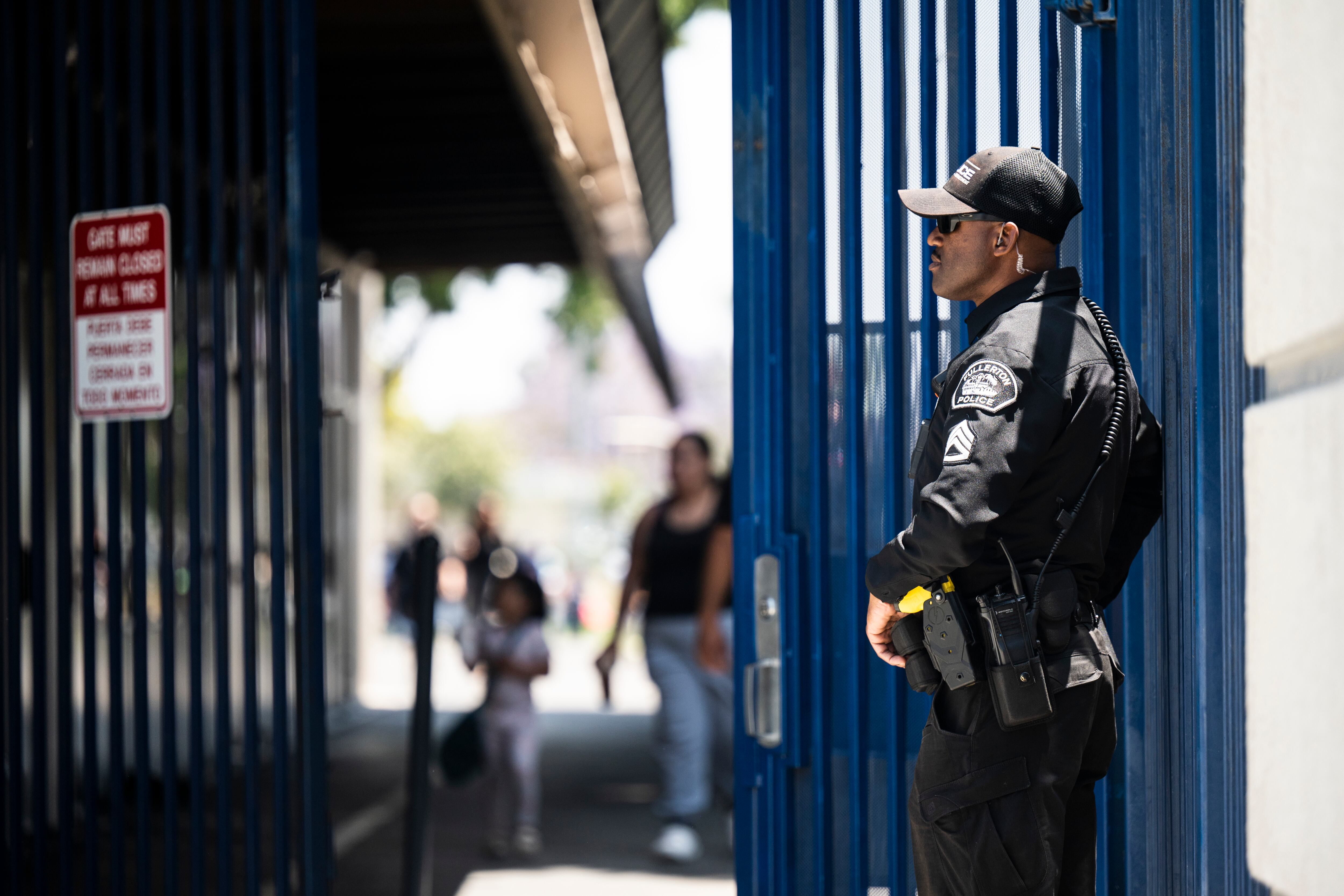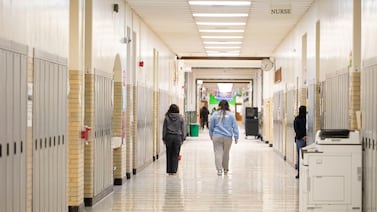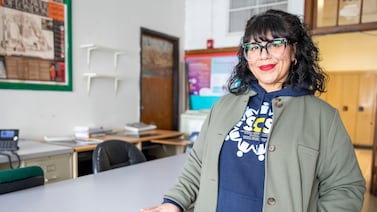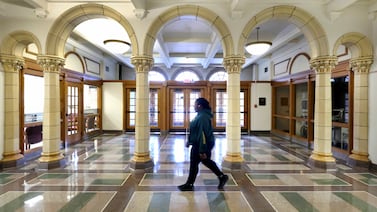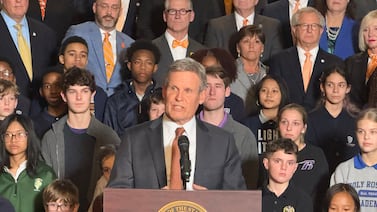A lot has changed for Broward County teacher Nympha Girard since a gunman shot and killed 17 students and staff members in her Florida district.
Girard, who teaches at Plantation High School, about 16 miles south of Marjory Stoneman Douglas High School, recalls that before the tragedy there in 2018, students and staff could enter and exit through multiple doors and gates. Students roamed the halls during class. Girard often stayed into the evening to help students. And there wasn’t much of a security presence.
Now, students, staff, and visitors filter through the “welcome center” — the only point of entry. When a student has to use the bathroom during class, Girard calls for a security guard to escort them. The gates lock after school lets out, which means teachers don’t stay too late. And her school has two police officers and a security manager who are “constantly in your vision.”
Those extra safety precautions do make her feel safer. “I understand we always have to look ahead and go one step further,” Girard said. But still, she’s torn about adding more security, and would prefer to see stricter gun laws. There’s been ongoing debate about adding metal detectors, Girard said, but she’s not convinced they “would make us any safer.”
Girard’s experience illustrates how many schools have already undergone “hardening” in the wake of prior high-profile tragedies. They have hired more security guards and police, installed cameras, added fences outside playgrounds, created one point of entry, and drilled students for the possibility of an active shooter.
Now, after the latest mass school shooting in Uvalde, Texas, some politicians and education officials want schools to tighten security even more. But the rapid adoption of these measures in recent years highlights how far schools have already gone — and raises questions about how much further they can and should go.
“Schools over the past couple decades have increasingly become more characterized by security measures,” said Chris Curran, an education researcher at the University of Florida. “The tricky balance for schools is we don’t want them to look like forts. We want students to go to a place where it’s welcoming, it’s open, where they’re happy to be there.”
In 2019, two thirds of schools reported having a school security or police officer present, according to a federal survey. That includes a majority of elementary schools and more than 80% of middle and high schools. In just over half of schools, at least one officer is armed with a gun.
Nearly all schools also report maintaining controlled access to their building during school hours, using security cameras, planning for the possibility of an active shooter, and conducting lockdown drills. More than half say they have controlled access to school grounds, too. There have been sharp increases in nearly all security measures in the last two decades.
Despite these security upgrades, politicians are still calling for measures that many schools already have.
Former President Trump, for example, said on Friday that every school building should have one point of entry, metal detectors, and “strong exterior fencing” to prevent intruders from entering schools with a weapon.
A number of Republican governors and some Democrats have shared similar sentiments.
“It’s looking for ways to harden schools,” Iowa Gov. Kim Reynolds said. “Maybe a single entrance into the school system and making sure educators are trained.”
Prior school shootings have led to the kind of school hardening that some are now calling for again.
Soon after the 2018 Florida shooting, a majority of states pumped money — totalling roughly $900 million, according to an analysis by The 74 — into bulking up security. The federal government has also issued regular safety grants.
The state of Florida began requiring schools to post an armed police officer or guard on every school campus and allowed some teachers to carry guns. The state also set aside $233 million to upgrade school building security over the last four years.
“This funding has made a great impact on schools’ abilities to secure their campuses,” said Cassie Palelis, a spokesperson for Florida’s education department.
Similarly, in 2016 after a community college shooting in nearby Oregon, Idaho passed a law requiring school “threat and vulnerability assessments” every three years.
Guy Bliesner, with the Idaho School Safety and Security Program, conducts some of those assessments. He visits nearly 100 schools a year looking for security lapses like whether doors are left open, and issues a detailed report for each school. Over the years, Bliesner had seen schools put in place more robust safety measures.
“There has been an increasing awareness of security as an operational element at schools,” he said.
Proponents of these measures point out that there are documented instances of school security guards and other police preventing school shootings that had been planned. And some research shows that police in schools can reduce crime unrelated to shootings.
But despite their prominence and horror, mass school shootings remain quite rare. In most years there are fewer than 10 active-shooter events in schools in the whole country. And it’s not clear if tougher security has made schools safer from shootings or other crime.
Schools in Uvalde, Texas, had undergone security upgrades — hiring police officers, conducting active-shooting trainings, and doubling their security budget.
In practice, as the Uvalde tragedy shows, security doesn’t always work as intended: in that case, a back door was left open, school security did not stop the shooter from entering, and local police let the shooter remain in a classroom for nearly an hour before a tactical team burst open the door.
And tougher security can come with real downsides: students may feel less safe at school, and may even do worse in class. Black students, especially, are more likely to be arrested at school and to have more negative feelings about school police.
“You end up creating an environment where you lessen the trust between students and the adults who should be nurturing and protecting them,” said Bacardi Jackson, who co-authored a report about school hardening after the Florida shooting for the nonprofit Southern Poverty Law Center.
Christina Quintero, who has three children in Houston ISD, watched as her children’s elementary school made changes to its building after the shooting at Texas’ Santa Fe High School in 2018. The district spent $3.4 million after Texas created a $100 million fund for school hardening. Her children’s school now has a single point of entry and staff are “hypervigilant” about who comes in. Visitors have to be buzzed through two sets of “big heavy” doors.
“It does make us feel more secure that our children are going through this,” Quintero said. But the calls from politicians for more spending on school security worry her. “I fear that putting more officers in these schools, putting metal detectors, and basically doubling down will further perpetuate the cycle of the school-to-prison pipeline, especially in minority areas.”
Quintero argues that school hardening doesn’t address the core problem: access to guns.
“That’s just a Band-Aid,” she said. “I guarantee you that it will fail, because we’re not addressing the root of the problem, which is gun violence and our elected officials accepting money from the NRA and not writing feasible policies that will actually protect our students.”
Meanwhile, in Florida, Girard said that repeatedly acting out an active shooter situation can be traumatizing.
“Sometimes things get too far,” she said. “Whenever the drills were over, when the classes moved, you could see it in everyone’s faces. We were all silently crying, because we were scared to death.”
The training has stuck with her in other ways, too. Girard doesn’t open the windows in her classroom now, even though they’re high off the ground. Two months ago, she cracked some for fresh air, but thought twice after worrying it could enable an intruder to hear her students during a lockdown. A student stood outside to listen as her class whispered and moved a chair.
“He said: ‘I heard something,’” Girard said. “So then I closed them.”
Right now, school officials are facing intense pressure to layer on even more security measures. Many parents are scared because of what they’re reading in the news. Many politicians are emphasizing security measures, with some hoping to pivot the conversation away from gun control laws.
Already many school systems have announced more police presence at least for the coming weeks. Some have laid out plans to update their security measures, too. The head of Los Angeles Unified schools, Alberto Carvalho, said the district was reviewing school access points and was considering using a tracking app to give first responders better access to schools.
But even some security experts say that officials need to avoid buying into quick fixes. Within days of the Uvalde shooting, Bliesner in Idaho said he’s received scores of emails from vendors hawking security products.
“Sometimes we just buy something and hang it out there so people say you did it,” he said. “It’s security theater.”
Kalyn Belsha is a national education reporter based in Chicago. Contact her at kbelsha@chalkbeat.org.
Matt Barnum is a national reporter covering education policy, politics, and research. Contact him at mbarnum@chalkbeat.org.

